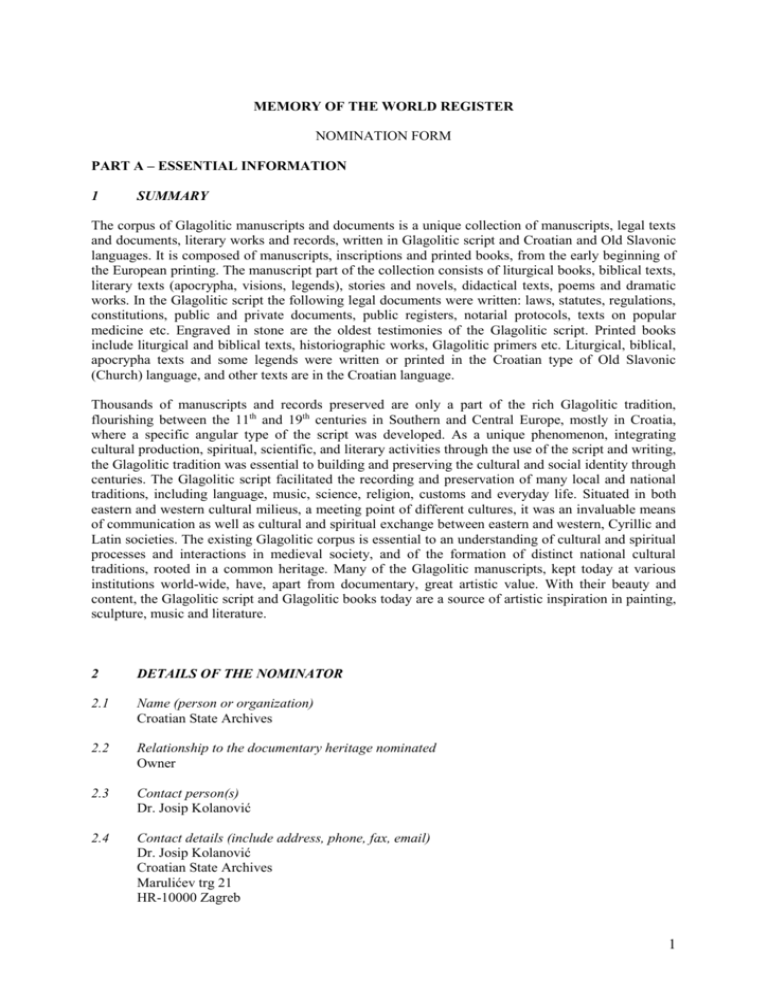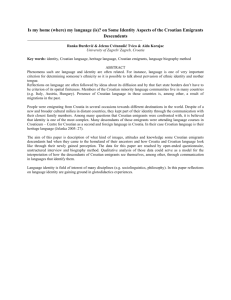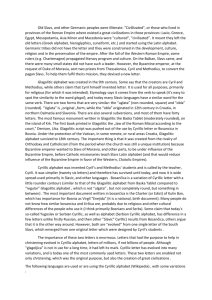MEMORY OF THE WORLD REGISTER
advertisement

MEMORY OF THE WORLD REGISTER NOMINATION FORM PART A – ESSENTIAL INFORMATION 1 SUMMARY The corpus of Glagolitic manuscripts and documents is a unique collection of manuscripts, legal texts and documents, literary works and records, written in Glagolitic script and Croatian and Old Slavonic languages. It is composed of manuscripts, inscriptions and printed books, from the early beginning of the European printing. The manuscript part of the collection consists of liturgical books, biblical texts, literary texts (apocrypha, visions, legends), stories and novels, didactical texts, poems and dramatic works. In the Glagolitic script the following legal documents were written: laws, statutes, regulations, constitutions, public and private documents, public registers, notarial protocols, texts on popular medicine etc. Engraved in stone are the oldest testimonies of the Glagolitic script. Printed books include liturgical and biblical texts, historiographic works, Glagolitic primers etc. Liturgical, biblical, apocrypha texts and some legends were written or printed in the Croatian type of Old Slavonic (Church) language, and other texts are in the Croatian language. Thousands of manuscripts and records preserved are only a part of the rich Glagolitic tradition, flourishing between the 11th and 19th centuries in Southern and Central Europe, mostly in Croatia, where a specific angular type of the script was developed. As a unique phenomenon, integrating cultural production, spiritual, scientific, and literary activities through the use of the script and writing, the Glagolitic tradition was essential to building and preserving the cultural and social identity through centuries. The Glagolitic script facilitated the recording and preservation of many local and national traditions, including language, music, science, religion, customs and everyday life. Situated in both eastern and western cultural milieus, a meeting point of different cultures, it was an invaluable means of communication as well as cultural and spiritual exchange between eastern and western, Cyrillic and Latin societies. The existing Glagolitic corpus is essential to an understanding of cultural and spiritual processes and interactions in medieval society, and of the formation of distinct national cultural traditions, rooted in a common heritage. Many of the Glagolitic manuscripts, kept today at various institutions world-wide, have, apart from documentary, great artistic value. With their beauty and content, the Glagolitic script and Glagolitic books today are a source of artistic inspiration in painting, sculpture, music and literature. 2 DETAILS OF THE NOMINATOR 2.1 Name (person or organization) Croatian State Archives 2.2 Relationship to the documentary heritage nominated Owner 2.3 Contact person(s) Dr. Josip Kolanović 2.4 Contact details (include address, phone, fax, email) Dr. Josip Kolanović Croatian State Archives Marulićev trg 21 HR-10000 Zagreb 1 Tel: +385 1 4801 902 Fax: + 385 1 4829 000 E-mail: hda@arhiv.hr 3 IDENTITY AND DESCRIPTION OF THE DOCUMENTARY HERITAGE 3.1 Name and identification details of the items being nominated Croatian Glagolitic heritage 3.2 Description The largest part of the Glagolitic books, manuscripts and inscriptions preserved world-wide have been microfilmed by the Croatian State Archives for preservation and reference purposes. This virtual collection, together with the collection of originals kept in archives, is intended to encompass all Glagolitic heritage still existing, thus enabling a comprehensive insight in, and the evaluation of, the whole of the Glagolitic heritage as a distinctive cultural phenomenon. The collection consists of originals (900 books and items) and microfilms (147,000 frames). There are over 500 preserved Glagolitic inscriptions (dated from the 11th to 18th centuries) in Croatia today, located in different places (about 200 different sites), among which Istria is the richest area. Other inscriptions are scattered mostly throughout the islands and along the Adriatic coast, and a smaller number is in the mainland of Croatia (especially in Lika). There are also many Glagolitic books, manuscripts and documents, in and outside Croatia, kept in different institutions in 24 countries, in about 60 cities, mostly in national libraries and museums (such as the University Library in Florence, Bibliothéque Nationale in Paris, Topkapi Saray in Constantinople, Princeton University Library, Austrian National Library, Vatican Library, Staatsbibliothek in Berlin, Basle University Library, Russian National Library, The Library of Congress in Washington, British Library, Oxford Bodleian Library, Hungarian National Library, Royal Library Denmark, Biblioteca Publica Municipal Portugal, Jagiellon Library in Krakow, National and University Library in Prague, etc.). As the Glagolitic script originated due to church liturgy requirements, the majority of monuments are related to liturgical and church needs. This includes items such as: missals, breviaries, psalters, lectionaries, rituals, miscellanies, sacerdotal hand-books, homilies, etc. The oldest examples of the Glagolitic script can be found in Croatia in the art of epigraph writing, dating from the 11th century. In the period ranging from the 11th until the end of the 18th century, there is a record of about one thousand Glagolitic inscriptions and graffiti. Most of the inscriptions relate to the building of churches or monasteries, to ecclesiastical inventories, as well as to the building and the content of private homes. They were also carved into the olive oil presses in cellars along the littoral, and on tombstones. The most important inscriptions from the 11th and 12th centuries are: the Plomin Tablet the Valun Tablet the Krk Tablet the Senj Tablet the Kijevci fragment the Baška Tablet and the Grdoselo fragment the Supetar fragment the Knin fragments the Plastovo fragment 2 As for graffiti the most important are the Glagolitic alphabets of Roč. The Church Slavonic of the Croatian type and the Glagolitic script were used for transcribing the books of the Bible, individual Biblical texts, Biblical quotations in non-liturgical books, all the books of the liturgy, the apocrypha and legends of the saints. Also in Glagolitic script and the Croatian language are the laws, statutes, land tenure documents, feudal dues document, monastic rules, constitutions, privileges, registers of births, marriages and deaths etc. The Croats possess an extensive collection of about 700 legal documents, statutes etc. written in the vernacular between the 12th and the 16th centuries - more than any other Slav nation. This extremely important collection of monuments called Acta Croatica represents a rich source for the study of the Medieval Croatian language. Most of the documents are written in the Glagolitic script, some also in the Croatian Cyrillic script. "Acta Croatica" is to be published by the Croatian Academy of Sciences and Arts. One of the earliest and most important Croatian legal documents is The Vinodol Code, very different from the Roman law, written in the Glagolitic alphabet in 1288. It was unique in Europe in that it provided for the protection and moral integrity of women. The Vinodol Code did not allow torture in legal proceedings, and is considered one of the most important documents of medieval Europe. Among the Slav Codes, only the Rus' Code "Pravda" is slightly older (1282). The first Croatian edition of the Vinodol Code was published in Zagreb in 1846. Two of its Russian translations with comments were issued soon after: in Moscow in 1846 and in St. Petersburg in 1878. A translation of the Vinodol Code into Polish appeared in 1856, and into French in 1896. The code was published in many European countries: it was translated into at least nine languages. There are many other important legal documents regarding medieval Croatia, of which mention should be made: Istarski razvod from the Istrian peninsula, 1275, written originally in three languages: Croatian in the Glagolitic script, Latin and German. Only the Croatian Glagolitic version has been preserved. With respect to its juridical and literary value it can be ranked among the most interesting documents of that time in Europe. It is also the oldest international diplomatic document written in Croatian. the Vrbnik Statute (on the island of Krk), written in 1388, the Kastav Statute (1490, near Rijeka), preserved in Latin, transliterated from the Glagolitic script, Moscenica Statute (~1501, Istria), preserved in Latin, transliterated from the Glagolitic script, the Veprinac Statute (1507, Istria), preserved in the Glagolitic script. In addition to the very rich sacred literature, there are thousands of other documents proving that the Glagolitic alphabet was also used in administration and in private communication. The oldest known Croatian non-liturgical verse (10 poems) are from 1380, written in cakavian dialect in the Glagolitic miscellany Code Slave 11, now kept at Bibliothéque Nationale, Paris. The Missal of Duke Novak from 1368 is considered a rare and valuable monument of the Croatian Glagolitic cultural heritage. It is kept at the Austrian National Library in Vienna. The book was written in Krbava (now a part of Lika). Many specialists consider this to be the most beautiful Glagolitic book. A facsimile edition is planned to be printed in the near future in Austria. Probably the most interesting Glagolitic book is the liturgical book called Missal of Hrvoje, written in 1404 by a Glagolitic scribe Butko. It has 94 beautiful miniatures, 380 colorful initials (some of them in gold), and has been kept in the Library of the Turkish sultans (Topkapi Saray) in Constantinople since the 16th century. It is written in two columns on 488 pp (22.5x31 cm) and also contains some rhythmic and melodic notation. The Croats brought the Glagolitic script to print in the very beginning of the European printing, in the 15th century, and used the Glagolitic script in print until the beginning of the 20 th century. Glagolitic books were printed not only in Croatia (Kosinj(?), Senj, Rijeka), but also in Venice, which had two Glagolitic churches at that time, and in Rome. Early Croatian printing becomes even more fascinating 3 when it is realized that at that time (the close of the 15th century) the invasion of the Ottoman Empire began. Many of the books in the Croatian Glagolitic script were printed with the generous support of the Croatian Protestants who were active in Wittenberg and Urach in Germany in the 16th century. About thirty books were printed in 25,000 copies between 1561 and 1565, 300 of which have been preserved. On the front page of the Glagolitic Catechism prepared by the Croatian Glagolitic priest Stipan Konzul of Istria and printed in the German city of Tübingen in 1561, it is explicitly stated that it is written in the Crobatischen Sprach (Croatian language). It is interesting to note that several editions were printed for the Italians living in Istria (of course, in Italian and in the Latin script). In 17th and 18th centuries Glagolitic books were printed in Rome. The last Croatian Glagolitic book (Missal) was printed in Rome in 1905. 4 JUSTIFICATION FOR INCLUSION/ ASSESSMENT AGAINST CRITERIA 4.1 Authenticity is established by scientific analysis of individual manuscripts and documents and by documentation about the history of the collection and its component parts. 4.2 The Glagolitic script was in use in Central and Southern Europe until the 20th century. Designed and introduced in 9th century as a means of spreading the Christian religion and ancient cultural heritage among the new peoples and nations in the region, it led to the production of wide variety of documentary and literary works that enabled communication and a rich cultural exchange among different cultures and civilizations. Glagolitic script facilitated the recording and preserving of many local and national traditions, including languages, music, science, religion, customs and everyday life, creating a distinct Glagolitic tradition deeply immersed in a broader context of Western culture and lasting more than eleven centuries. From literary and linguistic aspects, Glagolitic books and manuscripts, mostly produced in Croatia, or by Croatians, laid the foundation for the later development of Croatian literature and the Croatian standard language. 4.3 a) Time: Although there are many theories about the origin of the Glagolitic script, on the basis of preserved heritage the appearance of the Glagolitic script can be put in 9th century, although some researchers believe that the Glagolitic script is even older. In Croatia, the Glagolitic script came alive, developed and – different from other Slav countries – endured not only throughout the Middle Ages and the Renaissance, but even until the beginning of the 20th century, side by side with the Latin script, which the Croats used to write in their own language and in that of the Romans as early as from the 9th century. Today, the Glagolitic script is not in official or public use, and yet it still exists in everyday life in various ways. b) Place: As the oldest epigraphic/stone monuments in the Glagolitic script, those of the 11th, 12th and 13th centuries show, their greatest concentration is in Croatia (in the area of Istria, Kvarner and northern Dalmatia). The question whether this area represents the nucleus of the Croatian Glagolitic has not been solved. Historical, indirect records and certain fragments preserved on parchment frequently refer to regions lying further to the South. In the earliest period the Glagolitic script also existed in Ukraine, Bulgaria and Macedonia, but only until the 12th century, when the Cyrillic script became predominant. It is worth mentioning that besides these countries, the Glagolitic script was also in use in Bohemia, Bosnia, Romania, Moldavia and Russia in the Middle Ages. c) People: Although many theories have been expounded about the origin and genesis of the Glagolitic script, the accepted theory in scholarly circles is that the Glagolitic script was created as a completely new script in the second half of the 9th century for the Slavs of Moravia by St. Cyril. The Holy or Salonikan Brothers, Constantine-Cyril and Methodius, were sent on a mission by the Emperor of Byzantinum, 4 Michael III, at the invitation of the prince of Moravia Rastislav who decided to organize his church and state systematically, and this was impossible without a script or the basic ecclesiastical books. The Glagolitic heritage and glagolitism in general is related to great personalities of the Middle Ages and Renaissance such as Pope Innocent IV who gave the Croats special permission in 1248 to use their own – Glagolitic – script and language in liturgy, or the famous Czech king Charles IV of Luxemburg who built a Glagolitic convent Emaus (na Slovaneh) in Prague in 1347, to which Croatian Benedictines from the island of Pasman were invited as teachers. It is remarkable that the convent was just a few hundred meters away from the famous Charles’ University, built the next year, in 1348. One of the Glagolitic books from this convent (Emaus) in Prague came to Reims in 1574, where for centuries the French kings (Charles IX, Henry II, Louis XIII, Louis XIV) were sworn in by putting their hands on this holy book, known by the name Texte du Sacre or Évangéliaire de Reims. The Polish king Vladislaw II Jagiello also opened a Glagolitic convent in Krakow (Kleparz) in 1390, where Glagolitic priests were active for almost 100 years. d) Subject/Theme: Glagolitic heritage presents a source for the study of social, economic, political, religious and cultural life. It provides an abundance of data about names and surnames, the structure of government, the ambitions, undertakings and the creative potential of the society, a range of names of local builders, sculptors and painters. Glagolitic texts are precious source for linguistic studies, providing rich material for the study of Croatian and Old Slavonic languages, and social and comparative linguistics. Glagolitic heritage is highly important for the study of cultural exchange and communication between eastern and western cultural milieu in the Middle Ages and Renaissance. The "Glagolitic tradition" refers not only to the script, but also to the Old Slavonic (Church) language, the Old Slavic liturgy and medieval, liturgical and non-liturgical literature, written mainly in Glagoliza, an amalgam of the Croatian and Old Slavonic languages that united motives and forms of the eastern (Byzantine) and western origins, with a gradually growing prevalence of the latter. This entire complex of intertwining of the eastern origins and western superstructure, is usually known as Glagolitism. e) Form and Style: Glagolitic heritage exhibits aesthetic and stylistic characteristics of high value. The illumination of the Croatian Glagolitic manuscripts is characteristic mainly of the liturgical codices written in the upright script. From the 12th to the end of the 13th century the illumination of the manuscripts consisted essentially of pen and brush drawings, and was limited to initials and ornaments. In parallel to this, in the second half of the 14th century figurative motifs and miniatures began to appear as well. In the second half of the 15th and at the beginning of the 16th centuries in the illumination of Glagolitic books there are prevalent abstract geometric and stylized vegetal motives, that do not appear in Latin manuscripts of that time. Among the most beautiful illuminated Croatian Glagolitic manuscripts are the Missal of prince Novak from 1368, the Missal of Hrvoje Vukčić from the early 15th century, the Codices of Bartol Krbavac from the first decades of the 15th century and the two Vrbnik Missals of the 15th century. 4.4 Rarity: Many of the documents are original. The collection of copies is the only almost complete collection of Glagolitic texts. Integrity: 5 The Glagolitic documents, books and stone monuments are almost integrally in existence, but dispersed. The Glagolitic microfilm collection at the Croatian State Archives aims to re-establish the integrity of the Glagolitic heritage. 5 LEGAL INFORMATION 5.1. Owner of the documentary heritage (name and contact details) Croatian State Archives Marulićev trg 21 10000 Zagreb Croatia 5.2 Custodian of the documentary heritage (name and contact details, if different to owner) Dr. Josip Kolanović (Head of the Croatian State Archives) Croatian State Archives Marulićev trg 21 10000 Zagreb Croatia 5.3 Legal status: (a) Category of ownership Public (b) Accessibility Public access (c) Copyright status Copyright partly reserved to the owners. (d) Responsible administration Croatian State Archives (e) Other factors 6 MANAGEMENT PLAN 6.1 The management plan consists of normal procedures for safeguarding of, and access to, the holdings of state archives. Current preservation policy follows international best practice for the preservation of archival documents. Originals and microfilms are stored in a facility adapted for longterm preservation of paper documents and microforms. Because of the rarity and great significance of the collection a safety copy of each unit in the collection is stored in a secure place. Environmental and physical conditions are good. As the collection covers some 90% of all Glagolitic texts it is planned to continue microfilming in order to complete the collection. This preservation measure is highly important because the original documents are kept by many different institutions and there is a risk that some of them could be lost. In 2003, the project of systematic digitization is to begin which will enable on-line access to the collection. The access will be improved by a database, i.e. on-line inventory of the whole collection. 7 CONSULTATION 7.1 (a) Owner Croatian State Archives 6 (b) Custodian Croatian State Archives (c) Relevant Regional or National Memory of the World Committee (if appropriate) PART B – SUBSIDIARY INFORMATION 8 ASSESSMENT OF RISK 8.1 As the original manuscripts and documents are kept at many different institutions world-wide, there is a risk that some of them be lost or unavailable. The ongoing project of microfilming and digitization aims to prevent this. 9 ASSESSMENT OF PRESERVATION 9.1 Current preservation policy follows the international best practice for the preservation of archival documents. Originals and microfilms are stored in a facility adapted for long-time preservation of paper documents and microforms. Because of the rarity and great significance of the collection a safety copy of each unit in the collection is stored in a secure place. Environmental and physical conditions are good. PART C - LODGEMENT This nomination is lodged by: (Please print name)………………………………………………………………………... (Signature)………………………………… (Date)……………………………………… 7






